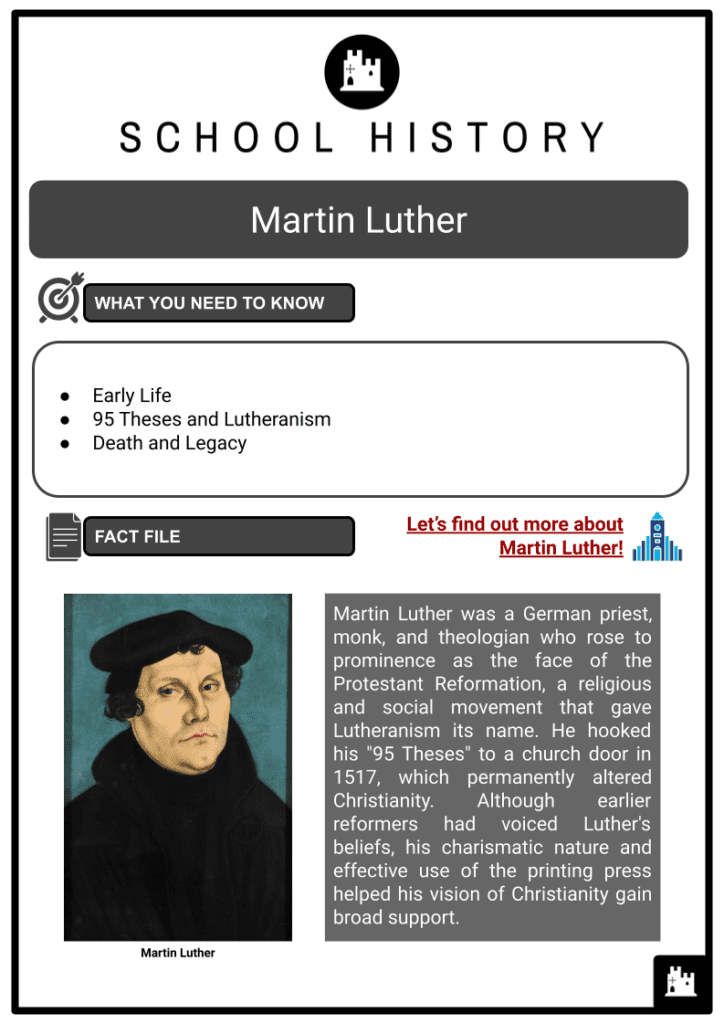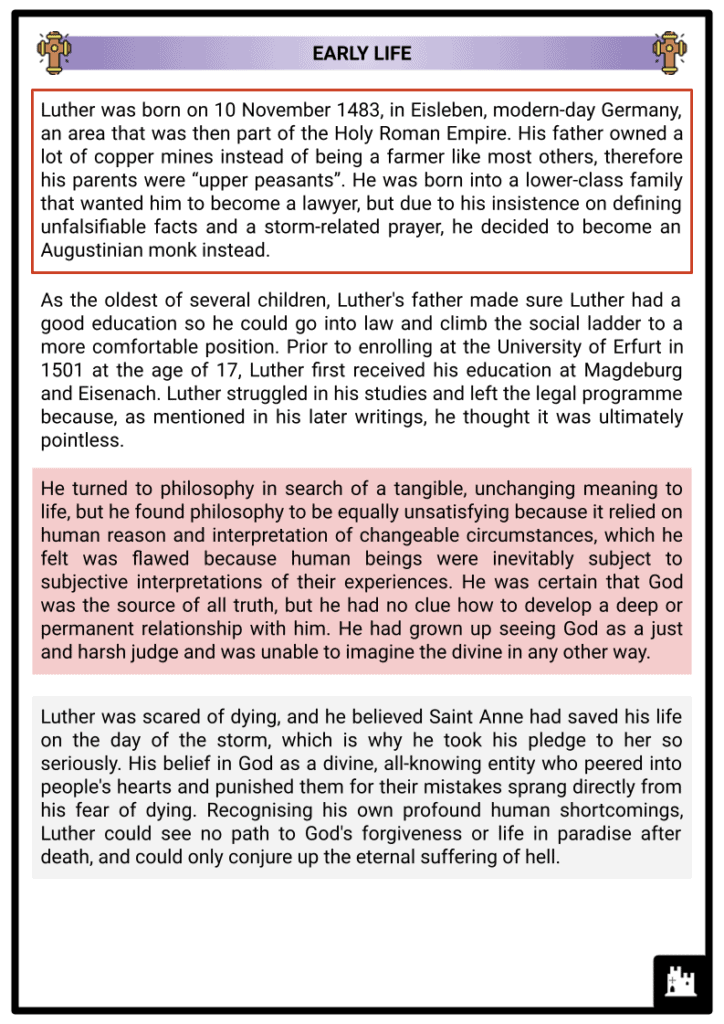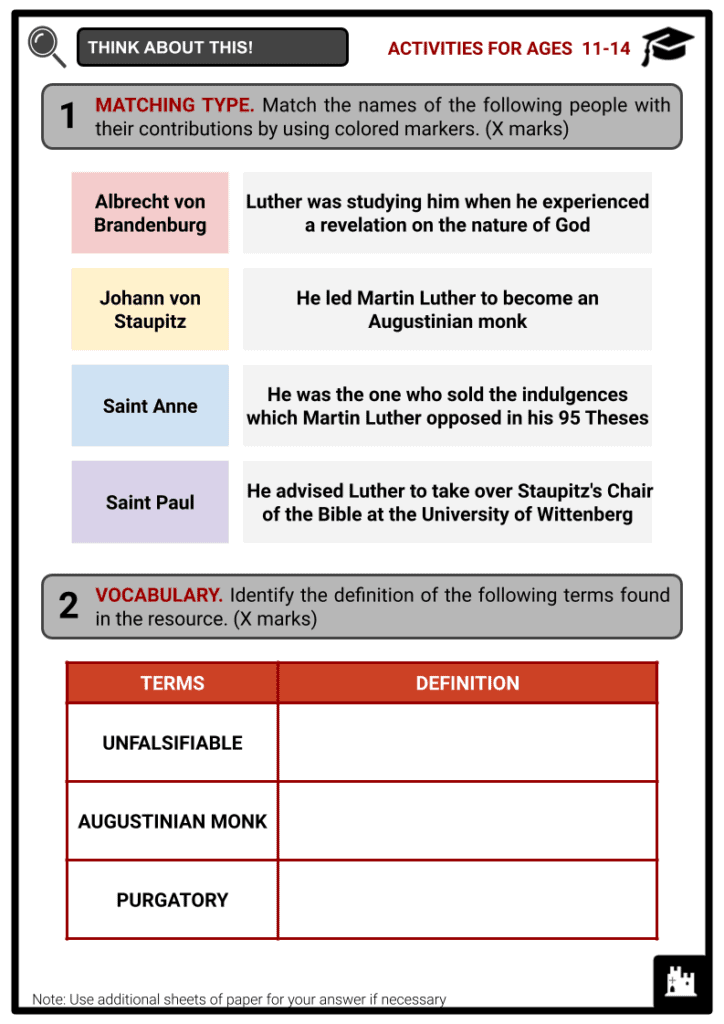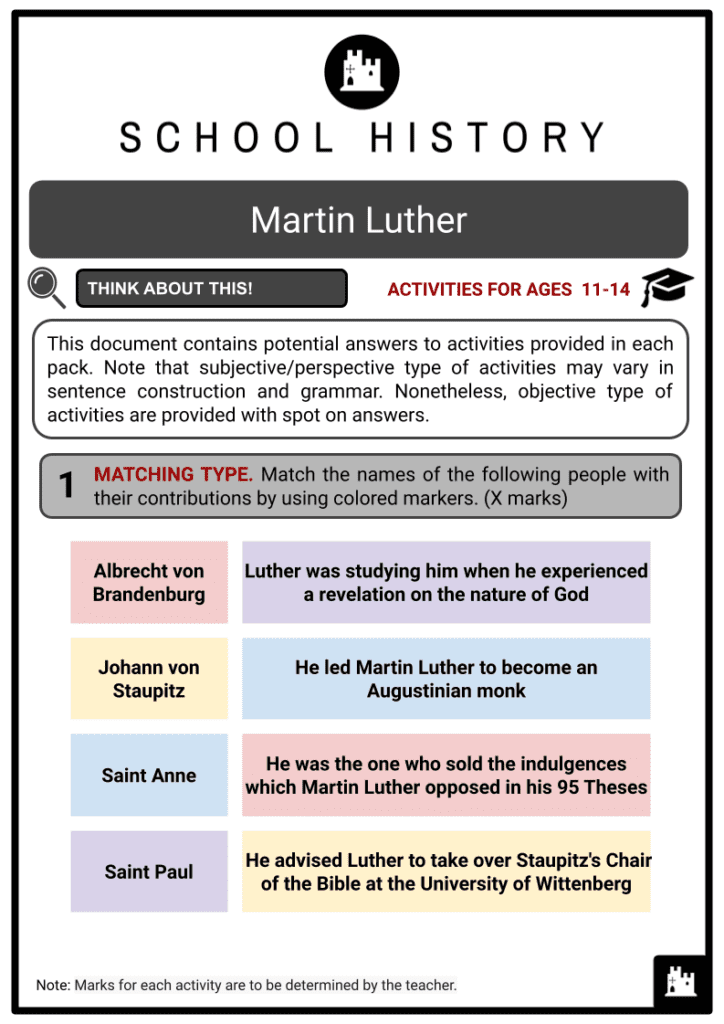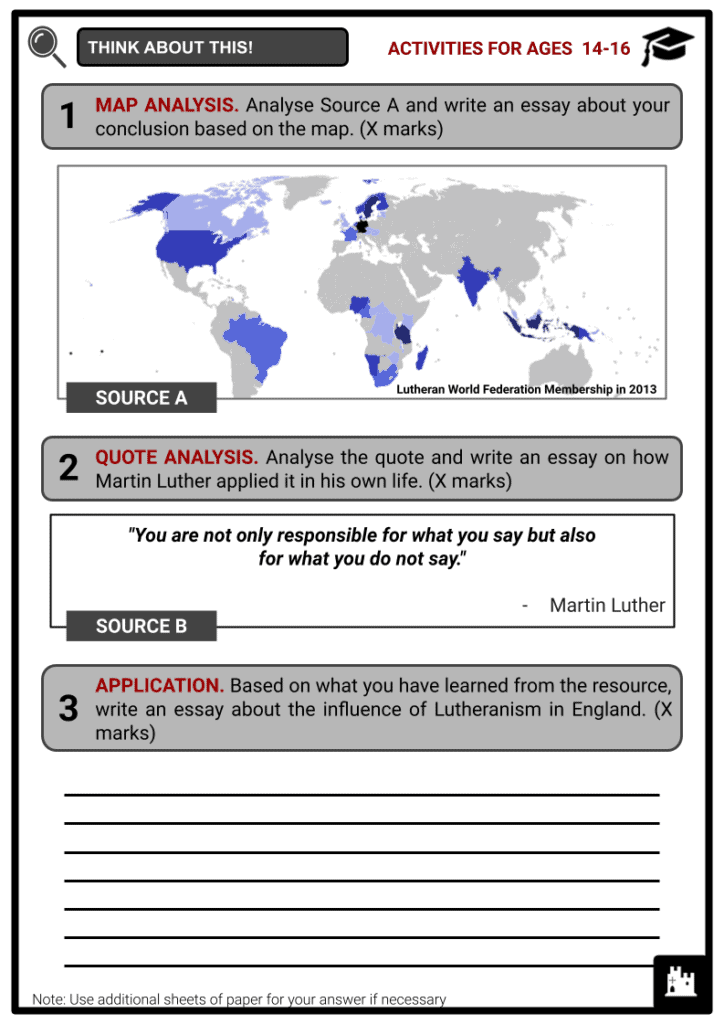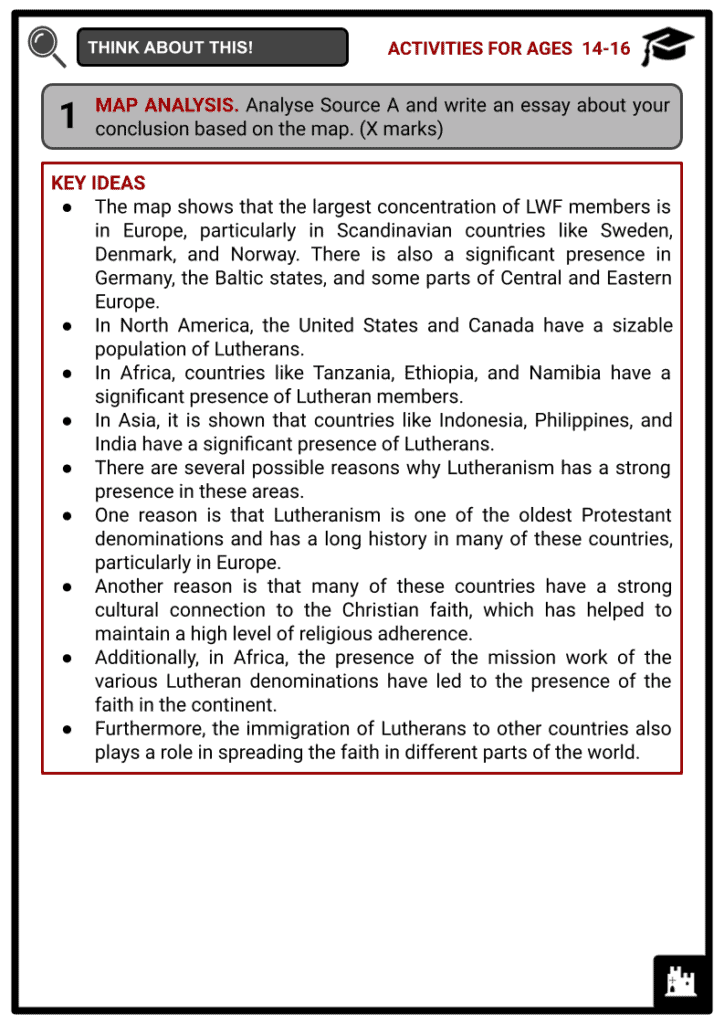Martin Luther Worksheets
Do you want to save dozens of hours in time? Get your evenings and weekends back? Be able to teach about Martin Luther to your students?
Our worksheet bundle includes a fact file and printable worksheets and student activities. Perfect for both the classroom and homeschooling!
Summary
- Early Life
- 95 Theses and Lutheranism
- Death and Legacy
Key Facts And Information
Let’s find out more about Martin Luther!
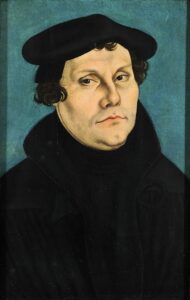
Martin Luther was a German priest, monk, and theologian who rose to prominence as the face of the Protestant Reformation, a religious and social movement that gave Lutheranism its name. He hooked his "95 Theses" to a church door in 1517, which permanently altered Christianity. Although earlier reformers had voiced Luther's beliefs, his charismatic nature and effective use of the printing press helped his vision of Christianity gain broad support.
EARLY LIFE
- Luther was born on 10 November 1483, in Eisleben, modern-day Germany, an area that was then part of the Holy Roman Empire. His father owned a lot of copper mines instead of being a farmer like most others, therefore his parents were “upper peasants”. He was born into a lower-class family that wanted him to become a lawyer, but due to his insistence on defining unfalsifiable facts and a storm-related prayer, he decided to become an Augustinian monk instead.
- As the oldest of several children, Luther's father made sure Luther had a good education so he could go into law and climb the social ladder to a more comfortable position. Prior to enrolling at the University of Erfurt in 1501 at the age of 17, Luther first received his education at Magdeburg and Eisenach. Luther struggled in his studies and left the legal programme because, as mentioned in his later writings, he thought it was ultimately pointless.
- He turned to philosophy in search of a tangible, unchanging meaning to life, but he found philosophy to be equally unsatisfying because it relied on human reason and interpretation of changeable circumstances, which he felt was flawed because human beings were inevitably subject to subjective interpretations of their experiences. He was certain that God was the source of all truth, but he had no clue how to develop a deep or permanent relationship with him. He had grown up seeing God as a just and harsh judge and was unable to imagine the divine in any other way.
- Luther was scared of dying, and he believed Saint Anne had saved his life on the day of the storm, which is why he took his pledge to her so seriously. His belief in God as a divine, all-knowing entity who peered into people's hearts and punished them for their mistakes sprang directly from his fear of dying. Recognising his own profound human shortcomings, Luther could see no path to God's forgiveness or life in paradise after death, and could only conjure up the eternal suffering of hell.
- He committed himself to a severe regimen of prayer, fasting, nearly daily confession of sin, and Bible study, yet he was unable to imagine a forgiving, loving God.
- He confided in his mentor Johann von Staupitz about his difficulties, hoping that he may be freed from the order.
- Staupitz, however, advised him to finish his Doctoral studies and take over Staupitz's Chair of the Bible at the University of Wittenberg.
- Luther refused to take this advice joyfully, claiming that following this path would result in his death.
- Staupitz reassured Luther, however, that if this were to happen, he would have enough to live in paradise after death.
- After receiving his degree in 1512, taking over Staupitz's post, and joining the university's faculty, Luther experienced a revelation on the nature of God somewhere around 1513 while studying Saint Paul's Epistle to the Romans. He was strongly moved by the line from Romans 1:17 that says, in part, "The just shall live by faith."
95 THESES AND LUTHERANISM
- As soon as he grasped the character of God as revealed in the Bible, he started to severely doubt the conception of God that the medieval Church had fostered. Luther reasoned that if salvation was based solely on one's own personal act of faith, what use were all the church's regulations, laws, and tithe requirements? The Church's doctrine of purgatory, the place where sinners were tormented in flames until their sins were forgiven and they were allowed to join paradise, has no foundation in the Bible. Even so, where was the Pope's justification in Scripture?
- Albrecht von Brandenburg, the archbishop of Mainz, requested permission from Pope Leo X to sell indulgences in his diocese in 1516, which heightened Luther's concerns about the purgatory period.

Luther’s Rose - Albrecht, who at the time was heavily in debt, consented to share the proceeds of the indulgences with Leo X in order to help him raise money for the restoration of Rome's Saint Peter's Basilica.
- Luther objected by penning his Disputation on the Power and Efficacy of Indulgences, also known as his 95 Theses, in 1516 when Leo X dispatched the Dominican friar Johann Tetzel to the area without his knowledge of the agreement the archbishop and the Pope had reached.
- Tradition holds that Luther pinned his paper to the Wittenberg Church door on 31 October, All Saints Eve, 1517, however contemporary study disputes this account. Later, Luther's friend and coworker Philip Melanchthon, who was not even at Wittenberg at the time, spread the legend of Luther and the church door. Nevertheless, academics agree that Luther would have been known for spectacular actions like nailing his arguments to the church door.
- Following the translation of Luther's theses into German, several challenges to ecclesiastical authority arose in Germany and later expanded to England, France, and other countries.
- However, the 95 Theses were neither a direct challenge to the Church nor something new. Only a month earlier, in September, Luther's 97 theses set forth his criticisms of scholastic theology. His 95 theses, originally written in Latin, simply offered 95 "talking points" for debate, but after they were translated and disseminated, they served as the impetus for reformation since the populace perceived them as a threat to the Church's power.
- The 95 Theses were delivered by Luther to Albrecht von Brandenburg, who had them checked for heresy and sent them on to Rome, regardless of whether they were put on the Wittenberg church door. Then Pope Leo X dispatched a number of envoys to convince Luther that he was mistaken, particularly with regard to his assertion that the Pope ought to finance the construction of St. Peter's Basilica rather than asking the people for alms. Cardinal Thomas Cajetan, one of the most well-known delegates, attempted to persuade Luther to return to orthodoxy at Augsburg in 1518 but was unsuccessful.
- Johann Eck was a famous theologian and a former friend of Martin Luther.
- Eck participated in a disputation with Luther and fellow reformer Andreas Karlstadt in Leipzig in 1519.
- He believed that without central authority interpreting scripture, it would lead to chaos as not everyone could understand it correctly.
- Eck argued that the Church relied on a scholarly tradition in interpreting the Bible, which he believed was the correct way of understanding it.
- He rejected Luther's claims about justification by faith. Luther refused to back down from his beliefs despite Eck's opposition.
- In 1520, the papal bull Exsurge Domine was issued, threatening excommunication for Luther's beliefs.
- Luther publicly burned the bull in Wittenberg in December 1520.
- Luther's teachings spread rapidly throughout Germany and other parts of Europe in the early 16th century, as people began to read and discuss his ideas. Many people were attracted to Luther's emphasis on salvation through faith alone, and his criticism of the sale of indulgences and other practices of the Roman Catholic Church. This led to the formation of new religious communities and the establishment of churches outside of the Catholic Church.
- The Lutheran Church was officially established in 1529 when a group of German princes, who had adopted Luther's ideas, presented the Augsburg Confession to the Holy Roman Emperor Charles V. The Augsburg Confession was a summary of Lutheran teachings, which outlined the basic beliefs of the Lutheran Church. This was an important moment in the establishment of the Lutheran Church as a distinct denomination.
- Lutheranism spread to Denmark, Sweden, Norway, and Finland in the following years, as state churches based on Lutheran teachings were established.
- Political reasons also played a role as it allowed them more autonomy from the Holy Roman Empire.
- Later on, it also spread to other parts of Europe, including Poland, Hungary, and Estonia, where a minority of the population, particularly among the nobility, adopted it.
- Today, the largest Lutheran communities are found in Germany, where it is the largest denomination, in Sweden, where it is the state religion, and in the United States, where it has been present since the colonial era and has grown through immigration.
- It is also present in other parts of the world, such as Australia, Canada, and Brazil.
- One notable figure who was influenced by Lutheranism was William Tyndale, an English theologian and Bible translator. Tyndale was heavily influenced by Luther's teachings, and his translation of the Bible into English helped to spread Lutheran ideas in England.
- Henry VIII of England initially opposed Lutheranism and wrote a book defending the Catholic Church's teachings against Luther's criticisms. However, his attitude toward the Protestant Reformation began to change in the 1520s and 1530s due to his frustration with the Catholic Church's refusal to grant him an annulment from his first marriage.
- In 1534, Henry passed the Act of Supremacy, which made him the head of the Church of England and formally separated it from Rome, driven by his desire for greater political control. While the Church of England remained fundamentally Catholic, Henry's break with Rome created space for Protestant ideas and practices to take root, leading to the Church of England becoming a distinct Protestant denomination.
- In the later years of the Elizabethan era, some of the Puritans who sought to further "purify" the Church of England, were also influenced by some of the teachings of the Lutheran Church. Though, the Church of England and the Puritans had different beliefs and practices, the puritans were influenced by the emphasis on the Bible as the only source of religious authority, and the priesthood of all believers. Though Lutheranism did not become a major denomination in England, it had an impact on the development of Protestantism and the Church of England.
- A number of English Protestants fled to continental Europe during the reign of Queen Mary I, where they were exposed to Lutheranism and other forms of Protestantism.
- Some of these exiles later returned to England during the reign of Elizabeth I and helped to spread the ideas of the Reformation.
- The Church of England was officially established as a via media, or middle way, between Roman Catholicism and Protestantism during the Elizabethan era.
- Individuals within the Church of England were influenced by Lutheranism, particularly in terms of their theology and emphasis on the priesthood of all believers.
- In the later years of the Elizabethan era, some Puritans who sought to further "purify" the Church of England, were also influenced by some of the teachings of the Lutheran Church.
- Though, the Church of England and the Puritans had different beliefs and practices, the puritans were influenced by the emphasis on the Bible as the only source of religious authority, and the priesthood of all believers.
DEATH AND LEGACY
- In his hometown of Eisleben, Luther passed away from a stroke on 18 February 1546, at the age of 62. In Wittenberg, he was buried in front of the altar of the same church where he had nailed his 95 Theses on the doors years earlier. By the time of his death, he was regarded by certain Protestant groups as a global hero while Catholics considered him as an unredeemable demon who had shattered the Church's unity and an instrument of Satan.
-
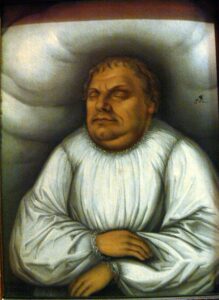
Luther in his deathbed Luther received criticism from even his supporters due to the way he handled the controversy surrounding Philip I of Hesse, whom Luther advised to lie about his bigamy, and due to his unwillingness to make concessions to other Protestant leaders at Marburg. In addition to being virulently antisemitic, Luther published a number of writings that denigrated Jews as "the other," preserving the stereotype that they were "Christ-killers" and a fallen race that had turned away from God's mercy.
- Although contemporary academics have provided a number of defences for this feature of Luther's personality, it is difficult to simply dismiss Luther as "a man of his time" because he was unquestionably exceptional in many ways. Nevertheless, even after his passing, his persuasive writing and oratory skills propelled antisemitism and hate crimes. In reality, the Nazi party of Germany in the 1930s and the early 1940s immensely loved Luther's works and used them as justification for genocide.
- His colleague, Melanchthon, observed his tendency to be stubborn, and his attitude toward Judaism seemed emblematic of this trait. Once he made up his mind about anything, he was reluctant to change his mind, as was the case when he rejected Copernicus' notion of the heliocentric world. No proof exists that he ever had meaningful interactions with any Jews, and it is most probable that he formed his antisemitism in the same manner that many people do today: by never challenging what they are told about individuals they have never met.
- In contrast to a man who was not afraid to challenge the teachings of the Church, which asserted to possess the keys to heaven and hell, this part of his personality is contradictory. Martin Luther is one of many notable people who have been mentioned in history who, despite their accomplishments, had flaws of varying degrees.

